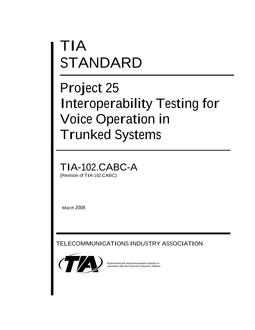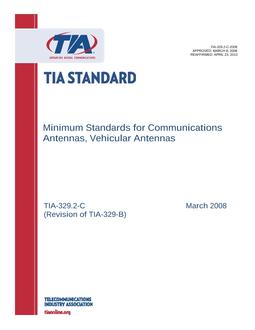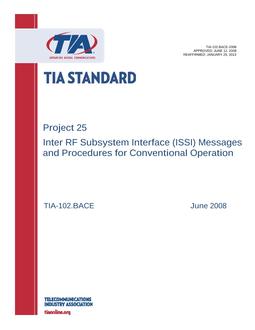-
-
Available Formats
- Availability
- Priced From ( in USD )
-
Available Formats
-
- Secure PDF 🔒
- Immediate download
-
$298.00Members pay $223.50
- Add to Cart
-
- Printed Edition
- Ships in 1-2 business days
-
$298.00Members pay $223.50
- Add to Cart
Customers Who Bought This Also Bought
-

TIA TIA-329.3-A
Priced From $123.00 -

TIA TIA-102.CABC-A
Priced From $189.00 -

TIA TIA-329.2-C
Priced From $107.00 -

TIA TSB-1065
Priced From $93.00
About This Item
Full Description
This specification is part of the "scope 2" ISSI work to add support for Consoles, Conventional, Packet Data, OTAR, and Supplementary Data to the ISSI. This specification covers console and fixed station support for conventional complexity level 1 and 2, defined below. The document focuses on complexity 1 because it is a new concept while complexity 2 re-uses the existing Scope 1 ISSI.
This specification introduces a new RFSS function, the "Conventional Arbitrator" or CAR. The CAR's function is to interconnect a multiplicity of conventional consoles employing Ec to a multiplicity of conventional stations employing Ef.
This specification describes in detail the P25 conventional complexity level 1 ISSI architecture. For the purposes of this document, the console subsystem is considered a type of RFSS. The CAR is considered a functional entity that can exist by itself, within an RFSS, or within a fixed station subsystem. When the CAR exists by itself it can be considered a conventional RFSS. The functions of a conventional RFSS are limited when compared to a trunking RFSS, and are limited to the functions defined herein.
This specification defines the protocol between the console subsystem and CAR, identifying it as Conv Ec. Conv Ec is one of the protocols which make up the ISSI. The interface between the Conventional Arbitrator and the fixed station remains Ef, as defined in TIA-102.BAHA. This specification briefly describes P25 conventional complexity level 2 architecture which utilizes the ISSI Scope 1 (SIP and RTP based) between the console subsystems and other RFSSs.
The conventional complexity levels are defined as follows:
Complexity 1: There is no mobility management, dynamic or static. If there is SU roaming, it is manual and the infrastructure does not track individuals, groups, or group members. The console has complete intimate control of the fixed station. Multiple consoles can interface to the same fixed station. Fixed stations are not connected together without console intervention. This complexity is most like legacy operation today. This complexity does not require air interface changes or modifications to existing subscribers.
Complexity 2: Fixed stations are connected together with static mappings. This complexity level is sometimes called "fixed mobility" because the location of groups and units are fixed and known a priori. Control of the fixed station is performed by the RFSS, not the consoles, This complexity utilizes the ISSI protocol (SIP and RTP) as the standard interface for inter-RFSS connections. This complexity does not require air interface changes or modifications to existing subscribers. Conventional groups behave, from an ISSI perspective, like trunking groups On each channel conventional IDs (UIDs and GIDs) are mapped to fully qualified SUIDs and SGIDs. System operator coordination is assumed to ensure that duplicate WUIDs do not show up on the same channel. This complexity also has conventional arbitration functionality internal to its RFSSs, similar to the CAR from complexity 1.
Complexity 3: Dynamic mobility is supported. Conventional subscribers register and affiliate over the air interface. Conventional groups look like trunking groups. A conventional station looks like a single channel trunking site. The protocol employed is the ISSI. Like complexity 2, conventional groups behave, from an ISSI perspective, like trunking groups and control of the fixed station is performed by the RFSS, not the consoles. This complexity requires air interface changes and modification to existing subscribers if the existing subscribers need to operate in this mode. This complexity is beyond the scope of this document.
For complexity 1, this specification builds upon the existing FSI Messages and Procedures document by creating a "one-to-many" interface. Multiple consoles can interface to the same station. To enable this requires an arbitration function between the consoles, provided by the CAR.
This specification enables consoles and fixed station support for:
• Conventional group and unit to unit voice calls on a fixed station.
• Station Intercom.
• Conventional station control on a fixed station.
• Conventional supplementary data on a fixed station.
• Conventional voter control on a fixed station.
While developed under Scope 2 of the ISSI, this specification is "Scope 1" of the Conventional Console Subsystem Interface (Conventional CSSI) because it defines an interface between a Console Subsystem and an RFSS (CAR). The system features which are NOT part of Scope1 and should be part of conventional station and conventional console interface Scope 2 or Scope 3 include:
• Console audio patch of conventional stations.
• Console interface to KMF.
• Console interface to a conventional Data System.
• Console ability to rekey a conventional subscriber radio.
• Console/logging device ability to monitor conventional group and unit-to-unit calls.





